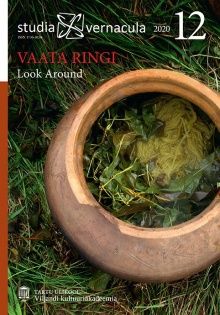Traditsioonilise käsitöö uurimine: toob mineviku tänapäeva ja loob tulevikku / Studying traditional crafts: bringing the past into the present and making a future
DOI:
https://doi.org/10.12697/sv.2020.12.200-209Abstract
Studying Traditional Crafts’ was the theme of a conference organised by the Estonian Native Crafts Department of the Viljandi Culture Academy, one of four colleges in the University of Tartu. The conference was held in Viljandi, November 12th-13th, 2019, to celebrate the 25th anniversary of the Department. Over one hundred people attended the conference, many from Estonia, but also delegates from Finland, Germany, Hungary, Ireland, Latvia, Norway, Sweden, Tajikistan, the United Kingdom, and the United States of America.
A conference is a collective sharing of ideas and points of view: knowledge and understandings are built collaboratively through critical reflection, cross-disciplinary exchange, consensus and sometimes by disagreement. This report of the conference is an interpretation and synthesis of its proceedings in generalised terms. For readers wishing to see specific presentations, most of them are available on the conference website: https://sisu.ut.ee/craftconference2019/lectures.
To be a craft practitioner is to be an ‘insider’, to work with tools and materials, drawing on a unique combination of experience, knowledge and skill, to produce useful or aesthetic objects. Many of the people who now study traditions and crafts are not themselves practitioners. There is a small but increasing number of people who are practitioners and who are conducting academic research on crafts, either on their own practices or on those of others. More people are involved in curation, conservation, preservation and renovation, mostly employed in the museums and heritage sectors. Higher education institutions (HEIs) have to cater for this growing demand.
The job of the researcher of traditional crafts is to unravel the biography of the object and its maker, to understand something of changing contexts. Here the abilities of the historical researcher and anthropologist are valuable. The more we know historically about how craft objects were made and the socio-economic and cultural circumstances in which the making took place, the greater is the heritage value.
In heritage re-creations, ‘authenticity’ is important, which in turn requires close attention to historical detail. Heritage and tradition are increasingly seen as components of national identity and crafts as a means of keeping that identity alive. Higher education about traditional crafts provides a framework for discussing tradition as a dynamic cultural process and critiquing it in environmental and societal terms at local, national and global levels.
HEIs have to be responsive to new ideas, new connections and emerging agendas. Many craft practices can be shown to be inextricably linked to landuse, which in turn has a major impact on biodiversity. Locally-based initiatives which integrate fulfilling employment with responsible land management are no longer rarities. People are making lifestyle choices which recognise tradition because of its contribution to quality of life and a good environment.
In response to these developments, the new courses and opportunities offered by HEIs are exciting, but they also call for innovative approaches to teaching and learning. The Viljandi conference addressed these challenges, giving voice to approaches from different national and cultural contexts and from different traditions of making and research.

